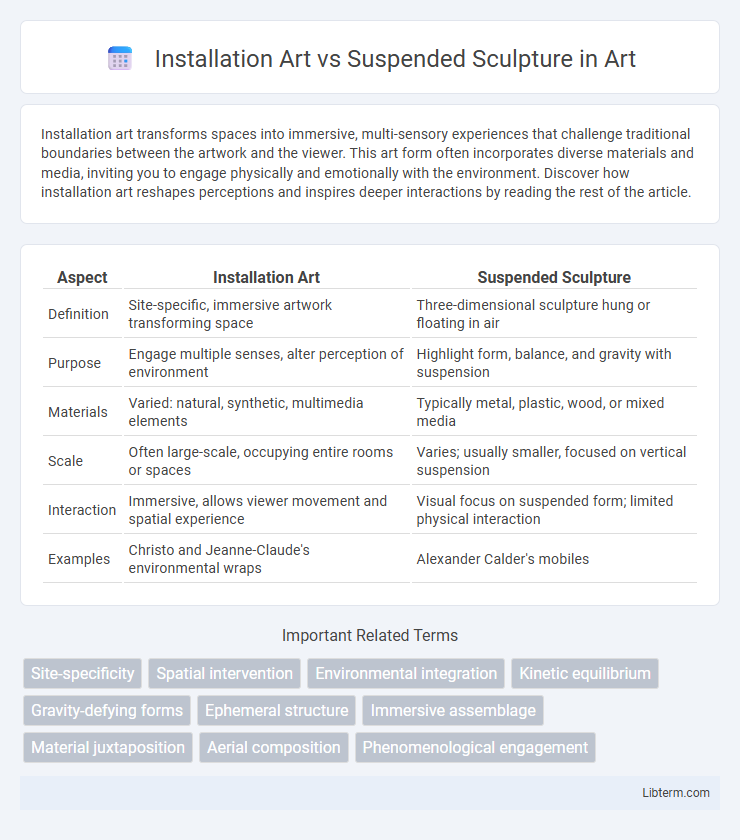Installation art transforms spaces into immersive, multi-sensory experiences that challenge traditional boundaries between the artwork and the viewer. This art form often incorporates diverse materials and media, inviting you to engage physically and emotionally with the environment. Discover how installation art reshapes perceptions and inspires deeper interactions by reading the rest of the article.
Table of Comparison
| Aspect | Installation Art | Suspended Sculpture |
|---|---|---|
| Definition | Site-specific, immersive artwork transforming space | Three-dimensional sculpture hung or floating in air |
| Purpose | Engage multiple senses, alter perception of environment | Highlight form, balance, and gravity with suspension |
| Materials | Varied: natural, synthetic, multimedia elements | Typically metal, plastic, wood, or mixed media |
| Scale | Often large-scale, occupying entire rooms or spaces | Varies; usually smaller, focused on vertical suspension |
| Interaction | Immersive, allows viewer movement and spatial experience | Visual focus on suspended form; limited physical interaction |
| Examples | Christo and Jeanne-Claude's environmental wraps | Alexander Calder's mobiles |
Defining Installation Art and Suspended Sculpture
Installation art immerses viewers by transforming entire spaces through mixed media, often incorporating sound, light, and interactive elements to create a cohesive environment that challenges traditional art boundaries. Suspended sculpture specifically refers to three-dimensional artworks physically hung or floating within a space, emphasizing balance, movement, and spatial relationships without enclosing the viewer. Both forms prioritize spatial experience, but installation art envelops and alters the environment while suspended sculpture highlights kinetic presence within that space.
Historical Origins and Development
Installation art emerged in the 1960s as an immersive, site-specific practice emphasizing spatial experience and viewer interaction, rooted in avant-garde movements such as Dada and Surrealism. Suspended sculpture traces its origins to early 20th-century mobiles pioneered by Alexander Calder, evolving through kinetic art to explore balance, movement, and spatial tension. Both forms demonstrate distinct historical developments: installation art prioritizes environment and context, while suspended sculpture focuses on element suspension and dynamic form within space.
Key Materials and Techniques Used
Installation art often incorporates diverse materials such as found objects, multimedia components, and environmental elements, using techniques like site-specific construction and spatial arrangement to engage viewers within a transformed environment. Suspended sculpture primarily utilizes lightweight materials such as metals, plastics, or fabrics, employing hanging, balancing, and kinetic methods to create dynamic movement and gravity-defying forms. Both art forms rely heavily on precise engineering and creative manipulation of materials to achieve immersive or visually compelling experiences.
Spatial Interaction and Audience Engagement
Installation art transforms entire spaces, encouraging immersive spatial interaction where viewers navigate and experience an environment shaped by artistic elements. Suspended sculptures focus on three-dimensionality, engaging audiences through dynamic perspectives as the artwork occupies and interacts with overhead space. Both forms challenge traditional viewing by fostering active participation and redefining the relationship between art, space, and observer.
Scale and Placement in Art Spaces
Installation art often occupies entire rooms or large environments, engaging viewers by immersing them within the space itself, while suspended sculptures typically hang or float, emphasizing three-dimensional form and interaction with the air and light around them. Installation works transform galleries into experiential zones with expansive scale, whereas suspended sculptures maintain spatial openness, relying on strategic placement to alter perception vertically and invite viewers to navigate beneath or around them. The distinct approaches to scale and placement create unique spatial dynamics, with installations dominating the environment and suspended sculptures enhancing spatial fluidity in art spaces.
Thematic Expressions and Interpretations
Installation art immerses viewers by transforming entire spaces to evoke thematic narratives that engage multiple senses and perspectives, often addressing socio-political or environmental issues. Suspended sculptures emphasize form, balance, and spatial relationships, allowing interpretations centered on movement, gravity, and light interaction within a defined volume. Both mediums explore space and perception, but installation art offers immersive, narrative-driven experiences whereas suspended sculptures focus on dynamic, physical interplay and abstract thematic expressions.
Notable Artists and Iconic Works
Installation art pioneers like Yayoi Kusama and Ai Weiwei create immersive environments such as Kusama's "Infinity Mirror Rooms" and Weiwei's "Sunflower Seeds," emphasizing spatial interaction and conceptual depth. Suspended sculpture artists including Alexander Calder and Tom Shannon are renowned for kinetic mobiles like Calder's "Lobster Trap and Fish Tail," showcasing dynamic balance and movement in three-dimensional space. Both forms redefine traditional sculpture by integrating viewer experience and environment, yet installations encompass entire spaces while suspended sculptures focus on airborne form and motion.
Challenges in Display and Preservation
Installation art presents challenges in display due to its site-specific nature, requiring adaptable exhibition spaces and careful consideration of spatial context. Suspended sculptures face preservation difficulties related to weight distribution and material fatigue, necessitating specialized mounting systems to prevent damage. Both demand ongoing maintenance strategies to ensure structural integrity and viewer safety in diverse environments.
The Role of Lighting and Environment
Lighting plays a crucial role in Installation Art by transforming spatial perception and enhancing immersive experiences through dynamic shadows, colors, and intensity variations. In Suspended Sculpture, lighting emphasizes three-dimensional forms and movement, casting intricate shadows that interact with the surrounding environment to create visual tension. The environment shapes how both art forms engage viewers, with Installation Art relying on site-specific contexts while Suspended Sculpture responds to ambient light and spatial volume.
Evolving Trends and Future Directions
Installation Art increasingly integrates immersive digital technologies and interactive elements, reflecting a trend toward multisensory and participatory experiences that challenge traditional spatial boundaries. Suspended Sculpture evolves by exploring innovative materials and kinetic designs, enhancing the perception of movement and light in three-dimensional space. Future directions suggest a convergence of both forms through augmented reality and environmentally responsive components, promoting dynamic artworks that adapt to viewer interaction and ecological contexts.
Installation Art Infographic

 libterm.com
libterm.com